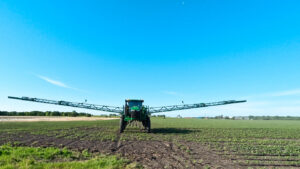Editor’s Note: Santiago Tenorio is group business development investment director at Cascade Global, a multi-family office based in the UK. Cascade is predominantly an early stage investor, investing in emerging technologies across artificial intelligence, robotics, fintech, and life sciences. The $100 million fund is also focused on investing for social impact, investing in entrepreneurs that aim to solve global challenges such as food security, social inclusion, healthcare and renewable energy.
Cascade recently made its first agriculture technology investments in Zynergy Solar and Raptor Maps. Here Tenorio writes about the financial return potential of agtech.
There are countless overused facts and figures that make a case for investment in agtech, but the opportunity to produce a financial return is a key point that is seldom associated with the space.
With global calorific demand set to increase by 70% over the next thirty years, there is, of course, an onus on those who can afford to help to do so, but we need not simply look at this as a humanitarian mission. Any other sector would look upon a 70% increase in demand as a huge financial opportunity, but areas like precision farming are surprisingly underserved by investors.

In recent months we have been redefining our investment framework, further developing our focus on investments that have a greater positive social or environmental impact. Cascade Global is a multi-family office which makes investments and is rooted in emerging markets, with strong ties to Asia and South America – two continents highly reliant on agriculture. We have also, historically, had a focus on exponential technologies, which was something we wanted to develop as we explored how to deliver tangible social impact.
The term impact investing has certain connotations in investment circles; it sounds expensive and unorthodox. What we have come to realize is that this couldn’t be farther from the truth. Part of our ethos has always been to back high-growth businesses. These are companies that operate in markets where they will not be bottlenecked by demand, where there is no ceiling to hinder growth, and have an idea that they can scale exponentially.
We are seeing technology applied in new and innovative ways. Artificial Intelligence techniques such as machine learning are harvesting data from farms in ways that would have been unfathomable 10 years ago. Novel sensor technologies are bringing a new level of precision to the industry. Robotic harvesters are automating processes, taking the strain from people. And large-scale data collection and analysis is set to disrupt entire markets.
Our first foray into agtech was in a company called Zynergy Solar. Zynergy develops and manufactures solar powered products including water pumps with sensors that monitor moisture levels and irrigate crops with a level of precision that was not possible in the region before. The products are also orders of magnitude more practical than previous solutions as they don’t corrode – meaning virtually zero maintenance requirements — and consume water resources with much greater efficiency, leveraging moisture data gathered by its sensors.
Our most recent investment is in Raptor Maps, a Y Combinator-backed precision agriculture company that uses advanced sensor systems, computer vision and machine learning algorithms to derive insights correlating harvest quality to farming conditions. The system determines which areas of the farm produce the best quality crops and why allowing farmers to implement targeted changes with real impact on the bottom line.
Unlike competitors, the sensors used by Raptor Maps are ‘delivery system agnostic’ and will work when attached to any vehicle, not just drones. Raptor Maps has successfully deployed this system on large farms in Idaho, Washington, Maine, and California; mapping farmers produce on a sub-acre basis. The system increases overall crop quality, reduces waste and cost, and ultimately increases efficiency, which in turn lowers prices for consumers. While there can be no doubt that this is cutting edge technology, our investment in Raptor Maps was not made entirely on the merit of the product, but largely on the team behind it.
There have been suggestions that we are experiencing an agtech bubble, exacerbated by an overabundance of risk capital compelling founders to focus on technology for the sake of technology rather than on solving real problems. In agriculture, this approach is not viable. Farmers are already working on tight margins, and do not have the capital that some Silicon Valley entrepreneurs are used to working with. If your product isn’t useful, no one will buy it, and it won’t even make it to the pivot phase. We were therefore impressed to find that the Raptor Maps team are on the ground in Idaho, working with farmers to ensure that the product they deliver ticks the right boxes. They are engineers who cut their teeth at MIT as well as NASA and Space X getting their hands dirty to ensure that their technology made the cut. This made our decision to invest far easier.
One of the biggest tangential developments of agtech is the application of big data. Farmers are now harvesting far more than just crops; they also harvest data, but currently do not have the tools at their disposal to make meaningful use of the information. (Companies like Raptor Maps can build proprietary data safes; mapping crop types, locations, and quality on a massive scale.)
This data has huge potential, not only in providing farmers with insights needed to improve yields and reduce costs but for a whole range of industries, one might not have considered.
Take farming insurance, for example; it is a multi-billion-dollar industry, which bases its policies on a rudimentary understanding of farming risk, developed on data gleaned from sources such as weather or soil moisture monitoring, at a very basic level. This approach is arbitrary; imagine if health insurance in the UK was based entirely on the weather!
By collecting meaningful data from companies like Raptor Maps, insurance providers will be able to more accurately forecast risk, providing more appropriate pricing for their policies and enabling them to underwrite the small farmers who are most in need of such coverage. This same line of argument can be made for the capital markets, economic modeling, and commodities trading. Of course, similar technology is on the market, but historically it has made use of third party satellites, which not only means that it is not an exact science given image resolution constraints, but that companies licensing the feeds don’t ultimately own any of the data collected. Precision farming tech companies that retain control over the data they capture will have a competitive advantage.
These exciting developments and opportunities make a compelling case for investment in agtech. The space has huge growth potential and is most of all an exciting frontier market sitting right at the cutting edge of technological advancements in a way that few other industries could ever hope to do. On top of that, its impact on the world makes it impossible to ignore, and its potential for profit makes it an irresistible investment proposition.
Want to write a guest article? Email [email protected]




